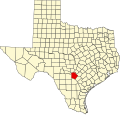References
- ↑ Allen & Regina Kosub (November 18, 2014). "The Old Gonzales Road". Lost Texas Roads. Retrieved April 28, 2021.
- ↑ "Cottage Hill | Texas Almanac". texasalmanac.com. November 22, 2010. Retrieved April 28, 2021.
- 1 2 3 "TSHA | Cottage Hill, TX". Handbook of Texas online. Texas State Historical Association. Retrieved April 5, 2021.
- ↑ The Monitor Guide to Post Offices and Railroad Stations in the United States and Canada: With Shipping Directions by Express and Freight Lines. Bullinger's Guides, Incorporated. 1876.
